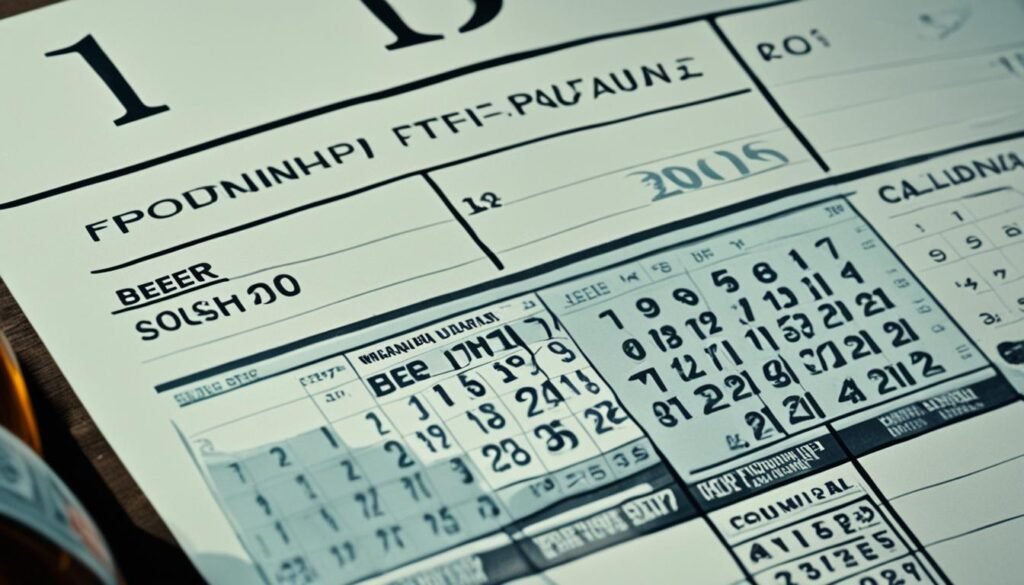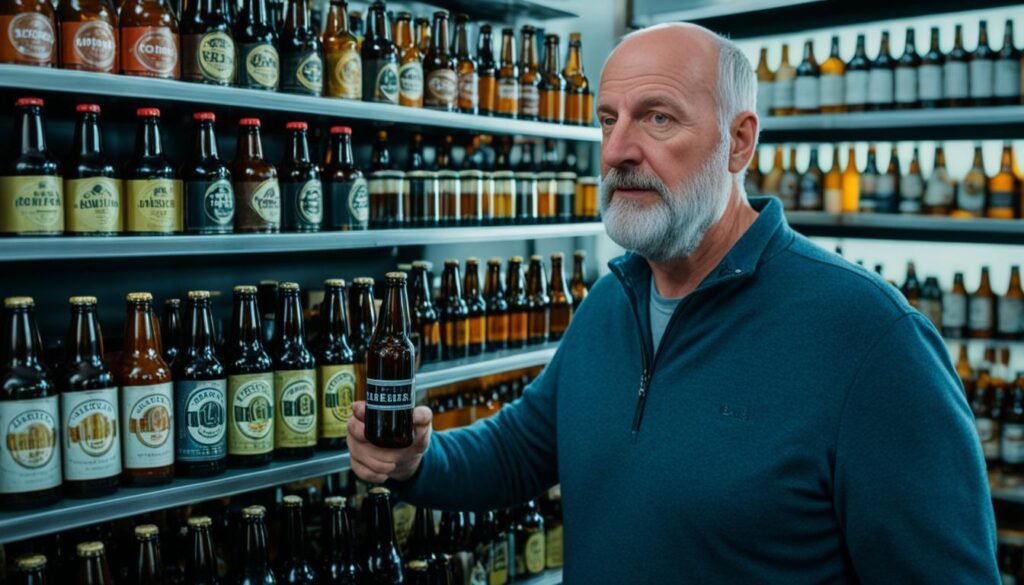For the casual drinker or the beer enthusiast, it might seem a bit perplexing to ask, “Does beer expire?”. The topic is more about quality than spoilage. While the concern of beer turning into a garden of pathogenic bacteria is virtually nonexistent thanks to alcohol and the antibacterial nature of hops, the facets of beer shelf life and the elements impacting the taste are indeed worth discussing. Whether you’re a homebrew fan or a constant patron of the finest microbreweries, understanding the dynamics of beer’s aging process is essential for preserving beer quality.
Indeed, there’s a conundrum that hop aficionados face – those delicious IPAs are not designed for the long haul. Their aromatic splendor is fleeting and preserving beer quality means enjoying them sooner rather than later. Learning proper beer storage tips can make the difference between a hoppy heaven and a bitter letdown. To extend the lifespan of these carbonated treasures, store beer in a fridge, or a cool, dark nook free from the damaging rays of the sun. Packaging also plays an undisclosed hero’s role, with brown glass bottles triumphing in shielding the liquid gold from UV rays.
Key Takeaways
- Beer doesn’t spoil like food but loses quality over time.
- IPAs and other hop-heavy beers lose their aromatic qualities quickly and demand prompt consumption.
- Checking the ‘best by date’ helps in determining how long the beer retains its intended flavor.
- For optimal preservation, store beer in a refrigerator or a cellar, away from direct sunlight and heat.
- Brown glass bottles provide superior protection against UV light, aiding in sustaining beer freshness.
The Truth About Beer Expiration
Uncovering the intricacies of beer freshness and its shelf life is akin to exploring a fine art. Master Cicerone Neil Witte and other industry experts concur that while can beer go bad, referring to its taste profile alteration, it poses no health hazards similar to spoiled foods. This is due to beer’s inherent defense against pathogen growth, primarily from its alcohol and hops content.
The key driver behind changes in the beer aging process is not bacterial degradation but chemical reactions. Oxidation and light exposure are the dual adversaries of a well-brewed beer. These elements have the potential to degrade the quality of even the finest beers, transforming their savory flavors into undesirable ones, even to the point of a skunk-like odor, recognized among connoisseurs as being ‘lightstruck’.
The essence of beer doesn’t age like food; rather, it transforms in flavor and aroma over time, which doesn’t inherently mean it’s unsafe to drink, but perhaps not as enjoyable.
Maintaining beer freshness requires particular attention to storage conditions to slow down the aging process:
- Avoid direct sunlight to prevent lightstruck reactions.
- Oxygen is beer’s nemesis; ensure airtight storage.
- Understanding the type of beer matters—some are crafted to age, while others peak fresh.
| Beer Type | Suitable Aging Time | Storage Tip |
|---|---|---|
| IPAs and Pale Ales | Consume fresh | Store cold away from light |
| Stouts and Barleywines | Can be aged | Store at cellar temperature |
| Sour Ales | Variable aging potential | Store cool with minimal light exposure |
| Lagers | Consume fresh to moderately aged | Consistent refrigeration |
As we navigate the odyssey of beer aging process, it becomes apparent that knowledge and care in storage directly influence a beer’s lifespan. Whether you delve into brewing as a craft or appreciate beer as an aficionado, embracing these practices is essential for ensuring every sip is savored in its intended glory.
The topic of can beer go bad is complex and laden with nuances. Ready for consumption or improvement through aging, beer’s journey from barrel to bottle to bliss is one of chemistry and careful cultivation. So next time you raise a glass, remember the intricate ballet of elements at play that maintain the beer’s delicate balance between fresh and foul.
Understanding Beer’s Shelf Life

When considering how long does beer last, beer enthusiasts and casual consumers alike may find that the answer isn’t straightforward. Several variables come into play, significantly affecting the longevity of beer. It’s these variables that brewers and consumers should be mindful of to ensure the optimal enjoyment of their beverages.
Variables Affecting Beer Longevity
The shelf life of beer can be influenced by numerous factors ranging from intrinsic properties of beer to the conditions in which they’re stored. High-alcohol beers or those with rich malt characteristics are often crafted to enhance their complexity over time. Be that as it may, most commercially available beers, particularly those that are hop-centric, offer the best taste when consumed fresh.
Implementing proper beer storage tips can have a profound influence on a beer’s shelf life. A few key guidelines include keeping beer away from direct sunlight to avoid the risk of it becoming ‘lightstruck’, and maintaining a consistent and cool temperature, preferably in a refrigerator.
Identifying the Best By Date on Beer
The best by date on beer can serve as a useful tool for consumers aiming to experience beer in its prime condition. Although not mandatory, breweries that prioritize the freshness and quality of their product will often include this date. It provides a helpful reference point for understanding the intended flavor profile and peak freshness of the beer, as envisioned by the craftsperson behind it.
Whether scrutinizing date codes for a “born on” date that signifies the brewing date, or an “enjoy by” date that predicts when flavors may start to fade, beer lovers invest in this knowledge as part of the enjoyment of their beverage. In truth, understanding a beer’s shelf life is as much about appreciating its intended character as it is about knowing how long the beer lasts.
Does beer expire? Insights From a Master Cicerone

The intricate beer aging process is demystified through the Master Cicerone insights of Neil Witte, whose discerning palate and extensive experience spotlight the pivotal factors in preserving beer quality. His tacit knowledge, cultivated over twenty fruitful years, unveils that the longevity and preservation of beer are conditional, varying remarkably between styles and brewing techniques.
Witte propounds that some beers, much like distinguished wines, are indeed brewed with the foresight of maturation, intended to evolve and refine over time. However, he equally emphasizes that to savor a beer as the brewer intended, one should consume it while it’s fresh. Doing so allows the drinker to experience the full spectrum of hop-induced flavors and aromas. These elements are ephemeral and most vibrant shortly after bottling, subtly waning as time progresses.
Neil Witte asserts, “Transparency in beer packaging dates is not just a courtesy—it’s a declaration of a brewery’s dedication to quality. I steer clear of beers that conceal their shelf life, as it suggests a disregard for the consumer’s experience of the beer at its best.”
Among aficionados and casual drinkers alike, there is an increasing understanding of and demand for clarity in labeling practices. This paradigm shift underscores a collective movement towards informed consumption, where the knowledge of beer’s optimal lifespan directly influences purchasing decisions. Knowledge of the expected duration of beer quality is critical in enabling the choice of beers that will provide the most authentic representation of the brewer’s craft.
- Examining Beer Packaging: Importance of Expiration Dates
- Curating a Beer Selection: Factoring Aging Potential
- Preservation Techniques: Ensuring Peak Freshness
Master Cicerone Neil Witte extols the virtue of mindful brewing and informed buying, as they both contribute significantly to the perpetuation of exemplary beer consumption experiences. By following his guidance on these aspects, we ensure that our appreciation for one of the world’s oldest and most cherished beverages continues to flourish.
Optimal Storage for Prolonging Beer Freshness
For aficionados and casual beer drinkers alike, understanding the critical role of storage conditions is central to preserving beer quality. Here, we delve into how maintaining the right environment can sustain beer freshness and provide practical beer storage tips to derive the best out of every pint.
Temperature and Light Considerations
The conservation of beer’s intricate flavors begins with temperature control. Keeping your brews between 38-50ºF is ideal for minimizing the risk of premature aging. Yet, consider not just the warmth but also the consistency of the temperature; fluctuations can be as damaging as inappropriately high temperatures. Light exposure is also a perennial enemy of beer preservation. Sun rays and even certain indoor lighting can start a photo-oxidation process that is detrimental to taste, leading to what’s often referred to as ‘skunked’ beer. For this reason, experts advocate for darkness as much as coolness in your choice of storage. A refrigerator offers a controlled space away from light, but for those with larger collections, a dark, cool cellar or cabinet is a practical alternative.
Minimizing Exposure to Elements
Equally noteworthy is beer’s vulnerability to oxygen once the seal of its container is broken. Oxygen can quickly erode the flavor profile of a beer, stripping away its fresh, bright qualities. To combat this, make sure to seal open containers tightly if not consumed in one sitting. Finally, take note of the 3-30-300 rule—an easy mnemonic that indicates how long a beer can retain its quality: 3 days at 90°F, 30 days at 72°F, and an impressive 300 days at an ideal 38°F. These figures underscore the importance of cool temperatures in extending the life and enjoyment of your favorite beers.
Beer Tasting Notes: Signs of Aging
For enthusiasts and brewers alike, the caliber of a beer can be observed through its tasting notes, which can serve as clear indicators of maturity. Aging, while a natural part of a beer’s lifecycle, leads to certain alterations in its profile that can detract from the desired qualities painstakingly crafted by the brewer. Understanding the flavor changes in aged beer and recognizing the signs of aging in beer are critical for both producers and consumers in maintaining the integrity of the beer experience.
Flavor Changes in Aged Beer
One of the prime markers of aging within beer is the inevitable process of oxidation. It manifests distinctly in the beer’s flavor profile, shifting it towards a more stale or flat experience that may remind one of the undesirable essence of wet cardboard. In terms of beer tasting notes, these flavor changes in aged beer offer a stark contrast to the fresh, vibrant notes that characterize a well-preserved brew. Such degradation is more pronounced in certain styles, especially those whose charm rests in their freshness and bold hop-driven character, like many modern IPAs.
Visual and Aromatic Indicators
A beer’s aging can also be gauged through visual and aromatic indicators. As a beer progresses past its peak, it may take on a murkier appearance, deviating from the crystal clarity or intended opacity initially presented. This visual cue often runs parallel to a diminishing hop aroma; the once-prominent scents of citrus, pine, or floral notes fade, leaving a palette less colorful in terms of scent. The loss of these aromatic and visual qualities not only impacts the overall enjoyment but serves as a reliable sign of aging in beer, guiding discerning drinkers towards fresher choices.
Beer Tasting Notes: Signs of Aging
Does beer expire?
Yes, beer does expire in that its quality and taste can degrade over time, but it does not become harmful like spoiled food. It’s essential to note that while beer doesn’t spoil in the traditional sense, it can develop off-flavors, lose freshness, and become less enjoyable to drink.
What affects the shelf life of beer?
The shelf life of beer can be influenced by multiple factors, including the beer style, beer storage conditions, packaging, and alcohol content. Hop-forward beers tend to lose their peak flavors faster than malt-focused or higher-alcohol beers, which may improve with age.
How can I tell if my beer is past its prime?
Checking for a ‘best by date’ if provided, observing any changes in taste, including off-flavors like wet cardboard, a decrease in hop bitterness or fragrance, changes in color, and a reduction in foam stability can all indicate that a beer has passed its prime.
How should I store my beer to preserve its quality?
Beer should be stored upright in a cool, dark place, ideally in a refrigerator or cellar where the temperature stays between 38-50°F. Keeping beer away from direct sunlight and sources of heat helps maintain freshness and prevents it from becoming lightstruck, which can quickly degrade its flavor.
Can beer go bad?
Beer can go ‘bad’ in the sense that it can taste stale or develop other undesirable characteristics. While it won’t spoil in a way that would make it unsafe to drink, you may not enjoy a beer that has aged poorly due to factors like oxidation and light exposure.
Does beer aging always lead to worse flavors?
Not necessarily. Some beers, particularly those with high alcohol content or designed for aging, like barleywines and imperial stouts, can develop more complex flavors over time. However, for most beers, especially light and hoppy styles, freshness is critical for the best taste.
How long does beer last?
The duration beer remains enjoyable to drink varies substantially based on style and storage conditions. As a rule of thumb, hoppy beers are best enjoyed soon after purchase, while strong ales and stouts may last longer, potentially improving with age. Adhering to the beer’s ‘best by’ date, if provided, is a good practice.
How do I interpret the best by date on beer?
A ‘best by’ date on beer serves as a guide from the brewer to indicate when the beer is likely to be at its peak quality. Beer may still be drinkable past this date but may have lost some of the flavors that the brewer intended to be experienced.
What do Master Cicerone insights reveal about beer aging?
Insights from a Master Cicerone, like Neil Witte, reveal that most beers are crafted to be consumed fresh, but some can age gracefully. Proper handling and storage conditions are critical to preserving a beer’s intended quality and sensory characteristics.
How important are packaging dates for beer freshness?
Packaging dates are significant as they can help consumers understand how long a beer has been in the market and how fresh it might be. Clear ‘best by,’ ‘packaged on,’ or ‘enjoy by’ dates are signs of a brewer’s commitment to freshness and quality.
What temperature is best for storing beer?
The ideal temperature for storing beer is between 38-50°F. Consistency in temperature is key, and colder environments slow down the aging process and help maintain beer’s freshness longer.
How can I minimize my beer’s exposure to elements?
To minimize beer’s exposure to elements that degrade its quality, store it in a dark place, away from UV light, in an upright position to reduce oxidation, and at a stable, cool temperature to slow down the aging process.
What flavor changes occur in aged beer?
Common flavor changes in aged beer include a loss of hop bitterness and aroma, development of staleness, and cardboard-like off-flavors due to oxidation. Some beers may also taste ‘sherry-like’ or develop other complex flavors if they are styles known to age well.
What are the visual and aromatic indicators of aging in beer?
Aged beers may exhibit visual signs such as haziness or sediment, a decrease in foam head retention, and a change in color, often becoming darker. Aromatically, the vibrant scents of hops may fade, and the beer may lose its original bright and inviting bouquet.
